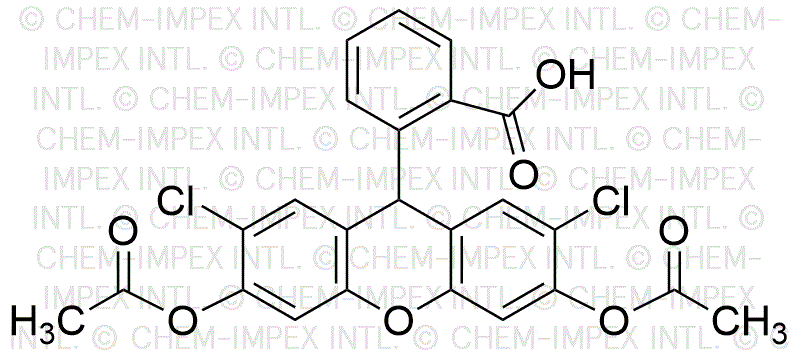- Cell Viability Assays: This compound is commonly used in assays to assess cell viability and proliferation. It can be converted into a fluorescent product, allowing researchers to quantify living cells in various biological studies.
- Reactive Oxygen Species (ROS) Detection: It serves as a probe for detecting reactive oxygen species in cells. This application is crucial in studies related to oxidative stress and cellular responses to different stimuli.
- Drug Development: In pharmaceutical research, it is used to evaluate the efficacy of new drugs by monitoring their effects on cellular health and oxidative stress levels, providing insights into potential therapeutic benefits.
- Fluorescence Microscopy: The compound is utilized in fluorescence microscopy to visualize cellular processes in real-time. Its fluorescent properties allow for detailed imaging of cellular structures and functions.
- Environmental Monitoring: It can be applied in environmental science to assess the impact of pollutants on microbial communities, helping researchers understand the effects of contaminants on ecosystem health.
Información general
Propiedades
Seguridad y normativas
Aplicaciones
- Cell Viability Assays: This compound is commonly used in assays to assess cell viability and proliferation. It can be converted into a fluorescent product, allowing researchers to quantify living cells in various biological studies.
- Reactive Oxygen Species (ROS) Detection: It serves as a probe for detecting reactive oxygen species in cells. This application is crucial in studies related to oxidative stress and cellular responses to different stimuli.
- Drug Development: In pharmaceutical research, it is used to evaluate the efficacy of new drugs by monitoring their effects on cellular health and oxidative stress levels, providing insights into potential therapeutic benefits.
- Fluorescence Microscopy: The compound is utilized in fluorescence microscopy to visualize cellular processes in real-time. Its fluorescent properties allow for detailed imaging of cellular structures and functions.
- Environmental Monitoring: It can be applied in environmental science to assess the impact of pollutants on microbial communities, helping researchers understand the effects of contaminants on ecosystem health.
Documentos
Hojas de datos de seguridad (HDS)
La SDS proporciona información de seguridad completa sobre la manipulación, el almacenamiento y la eliminación del producto.
Especificación del producto (PS)
La PS proporciona un desglose completo de las propiedades del producto, incluida la composición química, el estado físico, la pureza y los requisitos de almacenamiento. También detalla los rangos de calidad aceptables y las aplicaciones previstas del producto.
Certificados de análisis (COA)
Busque certificados de análisis (COA) ingresando el número de lote del producto. Los números de lote y de partida se pueden encontrar en la etiqueta de un producto después de las palabras "Lote" o "Lote".
Número de catálogo
Número de lote/lote
Certificados de origen (COO)
Este certificado de origen confirma el país en el que se fabricó el producto y también detalla los materiales y componentes utilizados en él y si se deriva de fuentes naturales, sintéticas u otras fuentes específicas. Este certificado puede ser necesario para cumplir con las normativas aduaneras, comerciales y regulatorias.
Número de catálogo
Número de lote/lote
Hojas de datos de seguridad (HDS)
La SDS proporciona información de seguridad completa sobre la manipulación, el almacenamiento y la eliminación del producto.
DownloadEspecificación del producto (PS)
La PS proporciona un desglose completo de las propiedades del producto, incluida la composición química, el estado físico, la pureza y los requisitos de almacenamiento. También detalla los rangos de calidad aceptables y las aplicaciones previstas del producto.
DownloadCertificados de análisis (COA)
Busque certificados de análisis (COA) ingresando el número de lote del producto. Los números de lote y de partida se pueden encontrar en la etiqueta de un producto después de las palabras "Lote" o "Lote".
Número de catálogo
Número de lote/lote
Certificados de origen (COO)
Este certificado de origen confirma el país en el que se fabricó el producto y también detalla los materiales y componentes utilizados en él y si se deriva de fuentes naturales, sintéticas u otras fuentes específicas. Este certificado puede ser necesario para cumplir con las normativas aduaneras, comerciales y regulatorias.


